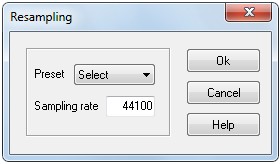This operation in digital signal processing involves converting a sampled signal from one sampling frequency to another without changing the period of the sample as would occur if the sampled audio was played at the new rate directly. Clicking Resampling menu item the following form shows up.

Enter the sampling rate you need to convert the current audio stream and click ok button.
Sampling rate
The sampling rate, sample rate, or sampling frequency (fs) defines the number of samples per unit of time (usually seconds) taken from a continuous signal to make a discrete signal. For time-domain signals, the unit for sampling rate is hertz, (samples per second). The reciprocal of the sampling frequency is the sampling period or sampling interval, which is the time between samples.

Sampling theorem
The Nyquist–Shannon sampling theorem states that perfect reconstruction of a signal is possible when the sampling frequency is greater than twice the maximum frequency of the signal being sampled, or equivalently, when the Nyquist frequency (half the sample rate) exceeds the highest frequency of the signal being sampled. If lower sampling rates are used, the original signal's information may not be completely recoverable from the sampled signal. For example, if a signal has an upper band limit of 100 Hz, a sampling frequency greater than 200 Hz will avoid aliasing and would theoretically allow perfect reconstruction.
The full range of human hearing is between 20 Hz and 20 kHz. The minimum sampling rate that satisfies the sampling theorem for this full bandwidth is 40 kHz. The 44.1 kHz sampling rate used for Compact Disc was chosen for this and other technical reasons.
Oversampling
In some cases it is desirable to have a sampling frequency more than twice the desired system bandwidth so that a steep digital filter and a less steep analog anti-aliasing filter can be used in exchange for a steep analog anti-aliasing filter. The reason for wanting a less steep analog anti-aliasing filter is that the digital filter is not subject to any component variations thus always giving the filter response (filtering function) that the designer has chosen. This process is known as oversampling
Undersampling
Conversely, one may sample below the Nyquist rate. For a baseband signal (one that has components from 0 to the band limit), this introduces aliasing, but for a passband signal (one that does not have low frequency components), there are no low frequency signals for the aliases of high frequency signals to collide with, and thus one can sample a high frequency (but narrow bandwidth) signal at a much lower sample rate than the Nyquist
A list of common audio sample rates
|
Sampling rate |
Use |
|
8,000 Hz |
Telephone and encrypted walkie-talkie, wireless intercom and wireless microphone transmission; adequate for human speech but without sibilance. |
|
11,025 Hz |
One quarter the sampling rate of audio CDs; used for lower-quality PCM, MPEG audio |
|
16,000 Hz |
Wideband frequency extension over standard telephone narrowband 8,000 Hz. Used in most modern VoIP communication products. |
|
22,050 Hz |
One half the sampling rate of audio CDs; used for lower-quality PCM and MPEG audio and for audio analysis of low frequency energy. |
|
32,000 Hz |
miniDV digital video camcorder, video tapes with extra channels of audio (e.g. DVCAM with 4 Channels of audio), DAT (LP mode), |
|
44,056 Hz |
Used by digital audio locked to NTSC color video signals (245 lines by 3 samples by 59.94 fields per second = 29.97 frames per second). |
|
44,100 Hz |
Audio CD, also most commonly used with MPEG-1 audio (VCD, SVCD, MP3). Originally chosen by Sony because it could be recorded on modified video equipment running at either 25 frames per second (PAL) or 30 frame/s (using an NTSC monochrome video recorder) and cover the 20 kHz bandwidth thought necessary to match professional analog recording equipment of the time. A PCM adaptor would fit digital audio samples into the analog video channel of, for example, PAL video tapes using 588 lines by 3 samples by 25 frames per second. Much pro audio gear uses (or is able to select) 44.1 kHz sampling, including mixers, EQs, compressors, reverb, crossovers, recording devices and CD-quality encrypted wireless microphones. |
|
48,000 Hz |
The standard audio sampling rate used by professional digital video equipment such as tape recorders, video servers, vision mixers and so on. This rate was chosen because it could deliver a 22 kHz frequency response and work with 29.97 frames per second NTSC video - as well as 25 frame/s, 30 frame/s and 24 frame/s systems. With 29.97 frame/s systems it is necessary to handle 1601.6 audio samples per frame delivering an integer number of audio samples only every fifth video frame. Also used for sound with consumer video formats like DV, digital TV, DVD, and films. The professional Serial Digital Interface (SDI) and High-definition Serial Digital Interface (HD-SDI)used to connect broadcast television equipment together uses this audio sampling frequency. Much professional audio gear uses (or is able to select) 48 kHz sampling, including mixers, EQs, compressors, reverb, crossovers and recording devices such as DAT. |
|
88,200 Hz |
Sampling rate used by some professional recording equipment when the destination is CD (multiples of 44,100 Hz). Some pro audio gear uses (or is able to select) 88.2 kHz sampling, including mixers, EQs, compressors, reverb, crossovers and recording devices. |
|
96,000 Hz |
DVD-Audio, some LPCM DVD tracks, BD-ROM (Blu-ray Disc) audio tracks, HD DVD (High-Definition DVD) audio tracks. Most pro audio gear uses (or is able to select) 96 kHz sampling, including mixers, EQs, compressors, reverb, crossovers and recording devices. This sampling frequency is twice the 48 kHz standard commonly used with audio on professional video equipment. |
|
Copyright (c) 2013 AudioDope team. All rights reserved.
|
|
What do you think about this topic? Send feedback!
|